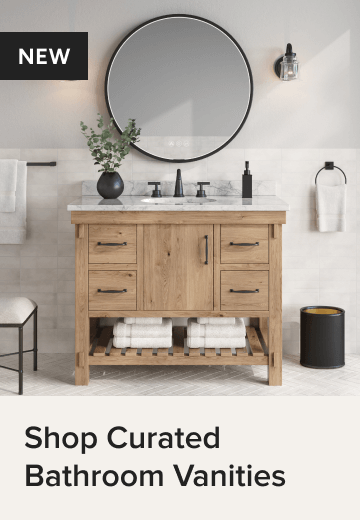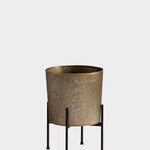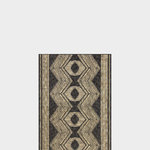FREE shipping on orders over $49!* Details
- All Products
- Kitchen & Dining
- Kitchen Fixtures
- Kitchen Sinks
Kitchen Sinks
Item 1 of 15
Sort by:
Price
6,002 Results
Best Seller
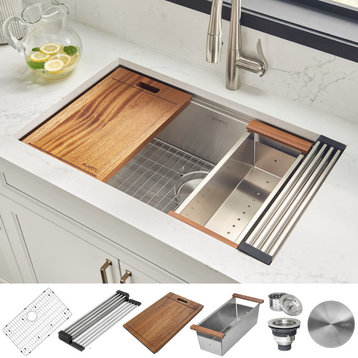
Ruvati 30" Workstation Undermount Stainless Steel Kitchen Sink, RVH8310by User(4)
$399
Convert your kitchen sink into a fully functional workstation with the Roma collection from Ruvati. Featuring an undermount installation and sharp inside corners, modernity is apparent. The workstation design features a built-in ledge that provides a platform for Ruvati’s unique accessories. Each sink in the Roma collection features a solid hardwood cutting board and decorative drain cover. Some also include a stainless steel colander or Ruvati’s patented foldable drying rack. With the Roma collection, you can do all your prep work on top of your sink and keep your countertops free of mess.
- WORKSTATION SINK: Ledges on the front and back provide a track for the included accessories.
- 16 GAUGE STAINLESS STEEL: Premium T-304 Grade (18/10 Chromium/Nickel) will never rust or stain.
- COMMERCIAL-GRADE BRUSHED FINISH: Easy to clean and long-lasting – hides scratches and matches well with your kitchen appliances.
- SOUNDPROOF COATING: Heavy duty thick rubber padding minimizes noise and reduces condensation.
- SHARP INSIDE CORNERS: Experience a more modern look.
- UNDERMOUNT INSTALLATION: Cutout templates and mounting clips are provided.
- FOLDABLE DRYING RACK (Patented by Ruvati): Constructed of stainless steel bars and a flexible silicone frame – ideal as a dish-drying rack.
- SUPERIOR WOOD CUTTING BOARD: Constructed of solid sapele wood (African Mahogany) that is resistant to water damage and scratches.
- STAINLESS STEEL COLANDER: Hangs nicely over the sink bowl – making it easy to rinse fruits and vegetables right on the sink.
- PROTECTIVE BOTTOM GRID: Made of stainless steel — protects the bottom of the sink from impact and scratches and allows water to flow freely.
- INCLUDES DECORATIVE DRAIN COVER: Hides the drain while allowing waste and water to flow freely.
- EXTERIOR DIMENSIONS: 30″ (wide) x 19″ (front-to-back)
- INTERIOR BOWL DIMENSIONS: 28-1/2″ (wide) x 16″ (front-to-back) x 10″ (bowl depth)
- MINIMUM BASE CABINETe: 33″
- 3.5″ DRAIN OPENING: Will fit any standard garbage disposal unit.
- Ruvati USA Limited Lifetime Warranty
Best Seller
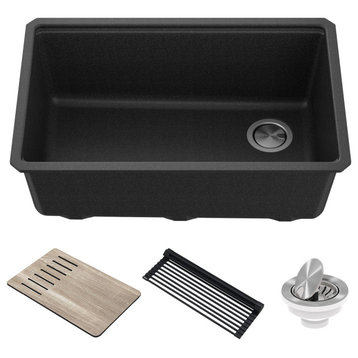
Bellucci 30" Undermount Granite Composite Single Bowl Sink, Metallic Blackby Kraus USA, Inc.(1810)
SALE
$363$1,025
Handcrafted in Italy, the Bellucci Workstation redefines granite sinks with enhanced functionality and modern style. An integrated ledge supports custom accessories that slide across the sink, streamlining your kitchen workflow from meal-prep to clean-up. The sink comes with a chef`s kit that includes a multipurpose roll-up drying rack and heavy-duty cutting board that allow you to work right over the sink without taking up counter space. The high-performance sink is made from an advanced quartz composite material with the look and feel of real stone. Undermount installation creates a seamless transition between sink and countertop, with no exposed mounting deck to trap food and debris. The large single bowl with rear offset drain maximizes usable workspace in the sink and easily accommodates for large pots, baking sheets, and stacks of dishes. Engineered for optimal draining, the gently sloped bottom prevents water from pooling in the sink. Extra-tough construction offers unparalleled resistance to impact, heat, and thermal shock. Designed with rounded corners and a non-porous surface, this sink is stain resistant and easy to clean. The vivid fade-resistant color is enhanced with UV protection to prevent discoloration over time. Premium stainless steel drain assembly is included.
WORKSTATION SINK: An integrated ledge allows you to work directly over the sink, with custom-fit accessories that save space on the kitchen counter and streamline everything from meal-prep to cleanup
OUTER SINK DIMENSIONS: 29 in. L x 19 in. W x 10 in. D, BOWL DIMENSIONS: 27 in. L x 16 in. W x 9 3/8 in. D, Minimum Cabinet Size: 33 in.
SINK KIT INCLUDES: Undermount granite composite workstation sink, heavy-duty cutting board, roll-up dish drying rack, drain assembly with strainer, mounting hardware
ADVANCED GRANITE COMPOSITE offers the look and feel of real stone with excellent resistance to hot plates, chipping, and thermal shock
SPACIOUS SINGLE BOWL: High-capacity sink with rear off-set drain creates an uninterrupted surface with generous workspace for large cookware and stacks of dishes, increases storage space underneath the sink
UNDERMOUNT DESIGN creates a seamless transition from countertop to sink for a contemporary look and easy cleaning, Simply wipe spills directly into the sink, with no exposed mounting rim to trap food particles and debris
ROLL-UP DISH DRYING RACK: Heavy-duty stainless steel dish rack with non-slip silicone is perfect for drying dishes and rinsing produce right over the sink, dishwasher-safe and holds up to 85 lbs.
HEAVY-DUTY CUTTING BOARD made from durable composite material not prone to warping or cracking, Non-porous surface is easy to keep clean
PERFECT DRAINAGE: Rear-offset drain opening and gently sloped sink bottom help prevent water from pooling in the sink, Optimized slope helps keep fragile glassware from tipping
EASY TO CLEAN: Non-porous material with a hard and smooth surface leaves fewer places where dirt and grime can hide, contributing to a cleaner kitchen environment
LOW MAINTENANCE: Rounded tight-radius corners and ultra-smooth surface easily wipe clean with soap and water, reducing messy build-up over time
HEAT SAFE up to 500 degrees Fahrenheit: Thermal shock resistant, will not crack from hot plates and cookware
FADE-RESISTANT color runs all the way through, Enhanced with UV protection to prevent discoloration over time
DRAIN ASSEMBLY INCLUDED: Premium stainless steel drain assembly with FlipCap creates a clean look while keeping your drainpipe free of debris, Pop-up style cover allows you to fill up the sink for soaking dishes
LIFETIME LIMITED WARRANTY with top-rated customer service available to support your needs
RECOMMENDED ACCESSORIES (sold separately): Keep your counters dry with a self-draining silicone drying mat (KDM-10) that drains water directly into the sink. Protect your sink with a premium stainless steel bottom grid (KBG-GR2514)
SECURE PACKAGING protects your products from damage in transit so that they arrive in perfect condition, ensuring that your renovation project gets off to a smooth start
PLEASE NOTE: Although Kraus granite and quartz composite sinks are highly heat resistant, placing hot items right from the stove or oven directly into the sink may cause surface discoloration. Consider using a trivet or rolling mat for extremely hot items to avoid potential damage
WORKSTATION SINK: An integrated ledge allows you to work directly over the sink, with custom-fit accessories that save space on the kitchen counter and streamline everything from meal-prep to cleanup
OUTER SINK DIMENSIONS: 29 in. L x 19 in. W x 10 in. D, BOWL DIMENSIONS: 27 in. L x 16 in. W x 9 3/8 in. D, Minimum Cabinet Size: 33 in.
SINK KIT INCLUDES: Undermount granite composite workstation sink, heavy-duty cutting board, roll-up dish drying rack, drain assembly with strainer, mounting hardware
ADVANCED GRANITE COMPOSITE offers the look and feel of real stone with excellent resistance to hot plates, chipping, and thermal shock
SPACIOUS SINGLE BOWL: High-capacity sink with rear off-set drain creates an uninterrupted surface with generous workspace for large cookware and stacks of dishes, increases storage space underneath the sink
UNDERMOUNT DESIGN creates a seamless transition from countertop to sink for a contemporary look and easy cleaning, Simply wipe spills directly into the sink, with no exposed mounting rim to trap food particles and debris
ROLL-UP DISH DRYING RACK: Heavy-duty stainless steel dish rack with non-slip silicone is perfect for drying dishes and rinsing produce right over the sink, dishwasher-safe and holds up to 85 lbs.
HEAVY-DUTY CUTTING BOARD made from durable composite material not prone to warping or cracking, Non-porous surface is easy to keep clean
PERFECT DRAINAGE: Rear-offset drain opening and gently sloped sink bottom help prevent water from pooling in the sink, Optimized slope helps keep fragile glassware from tipping
EASY TO CLEAN: Non-porous material with a hard and smooth surface leaves fewer places where dirt and grime can hide, contributing to a cleaner kitchen environment
LOW MAINTENANCE: Rounded tight-radius corners and ultra-smooth surface easily wipe clean with soap and water, reducing messy build-up over time
HEAT SAFE up to 500 degrees Fahrenheit: Thermal shock resistant, will not crack from hot plates and cookware
FADE-RESISTANT color runs all the way through, Enhanced with UV protection to prevent discoloration over time
DRAIN ASSEMBLY INCLUDED: Premium stainless steel drain assembly with FlipCap creates a clean look while keeping your drainpipe free of debris, Pop-up style cover allows you to fill up the sink for soaking dishes
LIFETIME LIMITED WARRANTY with top-rated customer service available to support your needs
RECOMMENDED ACCESSORIES (sold separately): Keep your counters dry with a self-draining silicone drying mat (KDM-10) that drains water directly into the sink. Protect your sink with a premium stainless steel bottom grid (KBG-GR2514)
SECURE PACKAGING protects your products from damage in transit so that they arrive in perfect condition, ensuring that your renovation project gets off to a smooth start
PLEASE NOTE: Although Kraus granite and quartz composite sinks are highly heat resistant, placing hot items right from the stove or oven directly into the sink may cause surface discoloration. Consider using a trivet or rolling mat for extremely hot items to avoid potential damage
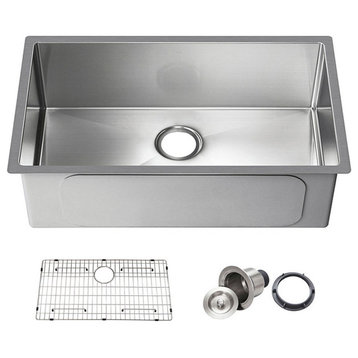
KIBI Handcrafted Undermount Single Bowl 16 gauge Stainless Steel Kitchen Sink, 3by Kibi USA(35)
SALE
$271$700
The distinctive, modern design of the KIBI undermount sink lends a contemporary vibe to your kitchen. This single-bowl sink, Handcrafteded from stainless steel, features small radius corners to maximize basin space
and a sloped bottom that helps with draining and cleanup. Sound Guard Plus system significantly reduces disposal and dishwashing noise.
Sound Guard Plus and Full Surface Undercoating: Extra 3mm thick rubber sound pads cover over 90% of sink base and bottom, with full undercoating to minimize noise and prevent condensation that can damage the kitchen cabinet
Built to be practical: 10” Deep Bowl, provide more space for washing dishes, and larger items without splashing and making a mess. 10mm Small Radius corners, are designed for extremely easy to clean but keep the chic look. Rear Set 3 ½” Drain, maximize the sink cabinet’s usable space.
Included in box: Sink, , Bottom Rinse Grid, Basket Strainer.
Limited lifetime warranty: Quality assured and protected by KIBI's warranty.
and a sloped bottom that helps with draining and cleanup. Sound Guard Plus system significantly reduces disposal and dishwashing noise.
Features
Premium T-304 Stainless Steel, Real 16 Gauge and Commercial Grade Brushed Finish:Superior quality, extra durability and 25% thicker than standard 18 gauge sinks for lasting longevity, performance and lustrous beauty.Sound Guard Plus and Full Surface Undercoating: Extra 3mm thick rubber sound pads cover over 90% of sink base and bottom, with full undercoating to minimize noise and prevent condensation that can damage the kitchen cabinet
Built to be practical: 10” Deep Bowl, provide more space for washing dishes, and larger items without splashing and making a mess. 10mm Small Radius corners, are designed for extremely easy to clean but keep the chic look. Rear Set 3 ½” Drain, maximize the sink cabinet’s usable space.
Included in box: Sink, , Bottom Rinse Grid, Basket Strainer.
Limited lifetime warranty: Quality assured and protected by KIBI's warranty.
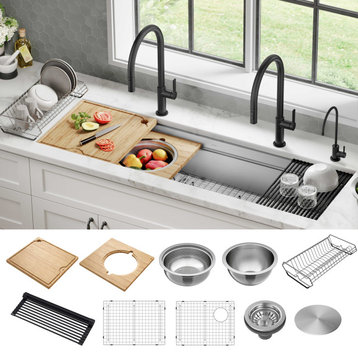
Kore Workstation 57" Undermount Stainless Steel 1-Bowl Kitchen Sink, Accessoriesby Kraus USA, Inc.(4454)
SALE
$1,082$3,035
Discover a whole new way to cook, serve and entertain with the 57-inch Kore Workstation Sink. An innovative 2-tier ledge system allows you to slide accessories across the sink on two levels, doubling your workspace and streamlining all kitchen tasks from meal prep to cleanup. The heavy-duty sink comes with a chef's kit of 10 premium accessories, including a solid bamboo cutting board, serving board set with bowl and colander, stainless steel dish rack, and multipurpose roll-up drying mat that allow you to work right over the sink without taking up counter space. This high-performance sink is made with KRAUS TRU16 - the thickest stainless steel on the market - for uncompromising industrial-grade durability. Undermount installation creates a seamless transition between sink and countertop, with no exposed deck to trap debris. The oversized 57 in bowl with offset drain creates an uninterrupted workspace that easily accommodates an entire party's worth of dishes and cookware, and offers enough room for multiple people to work side-by-side. A sloped bottom with channel grooves drives water toward the drain for complete drainage. The installation-ready package includes mounting hardware, a premium stainless steel drain with decorative cover, and two heavy-duty bottom grids to protect your investment. Ideal for single or double faucet installation, this sink pairs perfectly with Kraus Oletto High-Arc Kitchen Faucets KPF-2821 for a stunning kitchen design with pro-chef functionality.
THE ULTIMATE WORKSTATION SINK: Innovative 2-tier ledge system allows you to slide accessories across the sink on two levels so you can prep, serve, and clean up without losing any workspace on the kitchen counter
OUTER SINK DIMENSIONS: 57 in. L x 19 in. W x 10 1/2 in. D, BOWL DIMENSIONS: 55 in. L x 16 in. W x 10 in. D. Minimum Cabinet Size: 60 in.
SINK KIT INCLUDES: Stainless steel workstation sink, solid bamboo cutting board, serving board set with colander and mixing bowl, dish rack, roll-up drying mat, protective bottom grids (x2), drain assembly, decorative drain cap
HEAVY-DUTY 16 GAUGE SINK: Constructed from proprietary KRAUS TRU16, the thickest 16-gauge stainless steel for superior durability and resistance to dents and damage
OVERSIZED 57 in. SINGLE BOWL with offset drain creates an uninterrupted workspace that easily accommodates an entire party's worth of dishes and cookware. Ideal for entertaining with enough room for multiple people to work side-by-side.
LARGEST 2-TIER WORKSTATION BOWL: Patented design with wider mounting rim serves as the top workstation ledge, allowing for a double ledge design without reducing bowl width. Lower workstation ledge has a notch-style design that maximizes space inside the bowl
UNDERMOUNT DESIGN creates a seamless transition from countertop to sink for a contemporary look and easy cleaning. Simply wipe spills directly into the sink with no exposed mounting rim to trap food particles and debris
SUPER SILENT SINK: NoiseDefend soundproofing technology with thick super silencer pads that cover all sides of the sink eliminates noise and vibration. Fully insulated with anti-condensation undercoating that prevents water damage
BAMBOO CUTTING BOARD: Naturally non-porous bamboo resists stains
ROLL-UP DISH DRYING RACK made with heavy-duty stainless steel and non-slip silicone is perfect for drying dishes right over the sink. Holds up to 85 lbs., dishwasher-safe, heat-safe, and rolls up for easy storage
SERVING BOARD SET: Solid bamboo serving board holds an oversized stainless steel mixing bowl and colander. Perfect for tossing salads or straining pasta, the bowl and colander are made from food-grade rust-resistant stainless steel with non-slip silicone bumpers that prevent scratching
STAINLESS STEEL DISH DRYING RACK fits securely on the workstation ledge so you can dry dishes right over the sink without losing counter space. Constructed with commercial-grade steel, highly resistant to corrosion and rust
PROTECTIVE BOTTOM GRIDS: Premium stainless steel bottom grids (x2) protect the pristine surface of your sink by keeping dishes and heavy cookware elevated, eliminating the risk of scratches and dents. Soft rubber bumpers offer additional protection for the sink surface
DRAIN ASSEMBLY WITH COVER: Premium stainless steel drain assembly with strainer keeps your drainpipe free of debris. Removable decorative cover conceals drain opening and garbage disposal for a clean look
PERFECT DRAINAGE: Rear-offset drain opening and sloped bottom with channel grooves drive water toward the drain to allow for complete drainage. Optimized slope prevents fragile glassware from tipping
WEAR-RESISTANT FINISH easily stands up to everyday use, will not rust or dull over time
TIGHT-RADIUS CORNERS create a clean modern look with straight lines and perfectly right angles, maximizing usable workspace in the sink bowl
INSTALLATION-READY: Sink kit includes all mounting hardware and cutout template
LIFETIME LIMITED WARRANTY with top-rated customer service available to support your needs
THE ULTIMATE WORKSTATION SINK: Innovative 2-tier ledge system allows you to slide accessories across the sink on two levels so you can prep, serve, and clean up without losing any workspace on the kitchen counter
OUTER SINK DIMENSIONS: 57 in. L x 19 in. W x 10 1/2 in. D, BOWL DIMENSIONS: 55 in. L x 16 in. W x 10 in. D. Minimum Cabinet Size: 60 in.
SINK KIT INCLUDES: Stainless steel workstation sink, solid bamboo cutting board, serving board set with colander and mixing bowl, dish rack, roll-up drying mat, protective bottom grids (x2), drain assembly, decorative drain cap
HEAVY-DUTY 16 GAUGE SINK: Constructed from proprietary KRAUS TRU16, the thickest 16-gauge stainless steel for superior durability and resistance to dents and damage
OVERSIZED 57 in. SINGLE BOWL with offset drain creates an uninterrupted workspace that easily accommodates an entire party's worth of dishes and cookware. Ideal for entertaining with enough room for multiple people to work side-by-side.
LARGEST 2-TIER WORKSTATION BOWL: Patented design with wider mounting rim serves as the top workstation ledge, allowing for a double ledge design without reducing bowl width. Lower workstation ledge has a notch-style design that maximizes space inside the bowl
UNDERMOUNT DESIGN creates a seamless transition from countertop to sink for a contemporary look and easy cleaning. Simply wipe spills directly into the sink with no exposed mounting rim to trap food particles and debris
SUPER SILENT SINK: NoiseDefend soundproofing technology with thick super silencer pads that cover all sides of the sink eliminates noise and vibration. Fully insulated with anti-condensation undercoating that prevents water damage
BAMBOO CUTTING BOARD: Naturally non-porous bamboo resists stains
ROLL-UP DISH DRYING RACK made with heavy-duty stainless steel and non-slip silicone is perfect for drying dishes right over the sink. Holds up to 85 lbs., dishwasher-safe, heat-safe, and rolls up for easy storage
SERVING BOARD SET: Solid bamboo serving board holds an oversized stainless steel mixing bowl and colander. Perfect for tossing salads or straining pasta, the bowl and colander are made from food-grade rust-resistant stainless steel with non-slip silicone bumpers that prevent scratching
STAINLESS STEEL DISH DRYING RACK fits securely on the workstation ledge so you can dry dishes right over the sink without losing counter space. Constructed with commercial-grade steel, highly resistant to corrosion and rust
PROTECTIVE BOTTOM GRIDS: Premium stainless steel bottom grids (x2) protect the pristine surface of your sink by keeping dishes and heavy cookware elevated, eliminating the risk of scratches and dents. Soft rubber bumpers offer additional protection for the sink surface
DRAIN ASSEMBLY WITH COVER: Premium stainless steel drain assembly with strainer keeps your drainpipe free of debris. Removable decorative cover conceals drain opening and garbage disposal for a clean look
PERFECT DRAINAGE: Rear-offset drain opening and sloped bottom with channel grooves drive water toward the drain to allow for complete drainage. Optimized slope prevents fragile glassware from tipping
WEAR-RESISTANT FINISH easily stands up to everyday use, will not rust or dull over time
TIGHT-RADIUS CORNERS create a clean modern look with straight lines and perfectly right angles, maximizing usable workspace in the sink bowl
INSTALLATION-READY: Sink kit includes all mounting hardware and cutout template
LIFETIME LIMITED WARRANTY with top-rated customer service available to support your needs
Best Seller
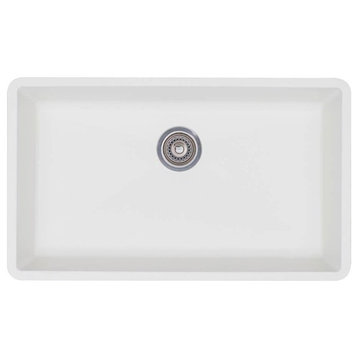
Blanco 440150 18.8"x32" Granite Single Undermount Kitchen Sink, Whiteby BLANCO(2233)
SALE
$584$809
- 80% solid granite, Silgranit material features the touch and feel of natural stone
- Undermount clips included
- Resistant to scratches, stains and all household acids and alkali solutions
- Heat resistant to 536 degrees F
- Non-porous, resists most household stains
- Required outside cabinet: 36-in
- Limited lifetime warranty
Best Seller

Rivage 33"x20" Stainless Steel, Dual Basin, Undermount Kitchen Sink, Goldby Swiss Madison(36)
SALE
$350$517
The Rivage Stainless Steel Dual Basin Undermount Sink is an enduring selection for any kitchen application. Its under-mounted design results in a smooth look and a flush mounting with any countertop material. A Rear offset drain allows for maximum undersink storage utilization.
Features
- Crafted of durable and long-lasting T304 Stainless Steel
- Extra sturdy 16 Gauge steel construction
- Sound proofing pads for superior noise absorption
- Features R10 corners for easy cleaning
- Undermounted sink offers 3 types of installation to match your design needs
- Gently sloping basin with engineered groves to boost draining
- 60/40 basins for tasks of any size
- Rear offset drain hole allows for maximum sink and under-sink cabinet storage needs
- 1 Year Limited Warranty Included
- Dimensions: 33" x 20" x 10"
- Drain and grid sold separately
Best Seller
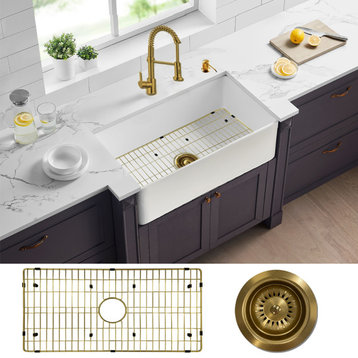
Ratel 30" True FireClay Apron FarmSink NOT Porcelain Sink Grid Strainer INCLUDEDby Ratel(7)
$407
"The design of the sink combines beauty, practicality, fashion and other elements, which can be matched with various styles of decoration to make your room full of design.
- Product name: farmhouse sink 33 inch
- Material: Fireclay
- Outer diameter: 30"" X 18"" X 10"" (762mm X 457mm X 260mm)
- Inner diameter: 28.5"" x 16.5"" x 8.5"" (724mm x 419mm x 216mm)
- Drain outlet: 3.75"" (95.25mm)
- Package includes: Fireclay Farmhouse Sink + Grid + Strainer
Product selling point:
- ✨1. The white farmhouse sink made of pure natural materials Fireclay, exquisite workmanship and rich in luster, is the perfect decoration for your home life.
- ✨2. The high-quality materials make the sink resistant to scratches and stains, the large-diameter design can easily drain sewage, and the cleaning method is simpler.
- ✨3. The sink with a variety of installation methods can be easily integrated into your home environment.
Reminder:
Due to the handmade nature of the product, its surface treatment, texture and other details will be different. The size may vary up to 1⁄8” (3mm)."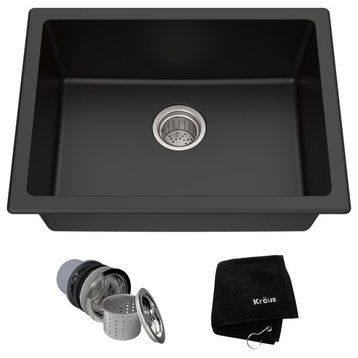
24" Drop-In Undermount Granite Composite Single Bowl Kitchen Sink, Blackby Kraus USA, Inc.(1600)
SALE
$202$270
- KRAUS 24 Inch Dual Mount Single Bowl Granite Kitchen Sink w/ Top Mount and Undermount Installation in Black Onyx
- Constructed from 80 percent Natural Granite
- Looks and Feels Like Real Stone
- Naturally Sound-Absorbing Non-Porous Surface is Easy to Clean & Heat-Resistant
- Protected by Thermal Finishing Process
- Highly Resistant to Heat, Chipping, and Discoloration
- Extra-Deep Basin Design
- Standard 3.5" Drain Opening
- Gently Rounded Corners for Easy Maintenance
- All Hardware Included for Dual Mounting Options
- Limited Lifetime Warranty
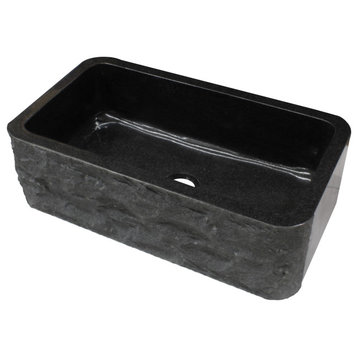
Single Bowl Kitchen Sink, Black Granite With Natural Chiseled Apronby Novatto
$3,207
Simply stunning and built to last. This premier black granite kitchen sink handles any job in the kitchen all while being the center of attention. Three sides are polished while the front apron is chiseled to showcase raw granite texture and color. Outside dimensions measure 33-inches left to right by 18-inches front to back. The total height is 10-inches. The sidewalls are a solid 1.5-inches thick which gives an inside dimension of 30-inches by 15-inches and inside height of 8.5-inches. Keep in mind this sink is beautifully crafted by our master artisans so dimensions may vary up to a quarter inch. Colors and variations may also vary a little since it is natural stone, but this black granite is very consistent. This sink is made with a standard 3.5-inch drain opening and is compatible with disposals. Be sure to reinforce this sink when installing as it weighs 270 pounds!
For minimal maintenance be sure to seal the sink with our Glacier Ice Sealer which is included. Made with the highest standards of quality and creative design, Novatto sinks add art and function to any room. This sink is packaged in a padded wooden crate to ensure a safe delivery. Just add water and enjoy Novatto's lifetime limited warranty.
For minimal maintenance be sure to seal the sink with our Glacier Ice Sealer which is included. Made with the highest standards of quality and creative design, Novatto sinks add art and function to any room. This sink is packaged in a padded wooden crate to ensure a safe delivery. Just add water and enjoy Novatto's lifetime limited warranty.
Blanco 440221 22"x33" Granite Double Dual-Mount Kitchen Sink, Whiteby BLANCO(2948)
$485
Both an expression of your individual style, and a testament to BLANCO's unsurpassed quality and craftsmanship - a variety of shape, sizes and features combine to bring you the DIAMOND collection. Every detail has been considered, from the large bowl capacity to the easy-to-clean, durable SILGRANIT surface. The BLANCO DIAMOND DUAL DECK EQUAL DOUBLE BOWL offers plenty of room for rinsing, washing, soaking, spraying and straining operations. Made from the rock hard, SILGRANIT patented surface, the DIAMOND kitchen sink features a smooth surface that is resistant to chips, scratches and heats up to 536F. Even a fork or the bottom of a hot pan can't damage BLANCO SILGRANIT sinks. The colorful, non-porous surface also makes the bowl resistant from all stains, household acids and alkali solutions as well as easy-to-clean. For three generations, BLANCO has quietly and passionately elevated the standards for luxury sinks, faucets, and decorative accessories. A family-owned company, BLANCO was founded over 85 years ago in Germany, and recently celebrated a milestone of 25 years in the United States where we are recognized as a leader in quality, innovation, and unsurpassed service. Create the ideal kitchen experience with the versatility of the DIAMOND collection.
- EASY INSTALLATION: Can be installed as either a drop-in or undermount for added convenience
- HEAT RESISTANT: Endures extreme temperature fluctuations and withstands up to 536F, exceeding common boiling and baking levels
- HYGIENIC & 100% FOOD SAFE: Patented Hygienic+Plus formula protects against bacteria and dirt
- SMOOTH SURFACE: Non-porous repellent surface pushes away dirt and residue, while maintaining the touch and feel of natural stone
- COLOR OPTIONS: Offered in 9 colors, SILGRANIT sinks match a variety of countertop materials, from natural stone to engineered stone
- EASY-TO-CLEAN: Daily cleaning may be done with any non-abrasive cleaner (Bar Keepers Friend, Soft Scrub with Bleach, Soft Scrub or dishwasher soap)
- SOLD SEPARATELY: Flange and basket strainer
- SATISFACTION GUARANTEED: Your BLANCO kitchen sink features a Limited Lifetime Warranty for added protection and complete peace of mind
Quarza 33" Drop-In Undermount Granite Composite 60/40 Kitchen Sink, Blackby Kraus USA, Inc.(2236)
$286
Add a modern touch to your kitchen with an elegant Quarza granite sink, made from 80% natural quartz for maximum durability with the look and feel of real stone. Highly resistant to scratches, scuffs, and stains. Installs as a drop-in or undermount.
- Outer Sink Dimensions: 33 in. L x 22 in. W x 10 5/8 in. D, Min Cabinet Size: 36 in. Undermount / 36 in. Topmount
- Non-Fading Color: UV-stable material offers a rich hue that will not fade or discolor over time
- Undermount / Drop-In Design: Install as an undermount for a seamless transition from sink to countertop, or drop into an existing countertop opening
- Heat-Safe: Can withstand high heat and extreme hot or cold temperature fluctuations
- Non-Porous Surface: Smooth to the touch surface is highly resistant to dirt and grime, and easily wipes clean
- Naturally Sound-Absorbing: Sturdy stone-like material absorbs vibration and minimizes noise when sink is in use
- Rear-Set Drain is compatible with all garbage disposal adapters, increases workspace in the sink and storage space in the cabinet below
- Kit Includes: Quarza Series Sink, Mounting Hardware, Cut-Out Template, Installation and Care Instructions
- Lifetime Limited Warranty: We stand behind our products with the highest standards of quality
- ISTA Certified Packaging protects sink from damage due to impact in transit and during loading, eliminating delays for renovation projects
- Product Certification: All Kraus products are marked cUPC, for assurance that the product meets all North American standards
- Compatible with Kraus Stainless Steel Colander: CS-2
Best Seller
LaToscana Reversible Fireclay Sink in White, 27"by LaToscana(39)
SALE
$567$662
LATOSCANA fireclay kitchen sinks bring our inspired collection of Farmhouse sinks to your home and feature a reversible design. Choose between a simple, decorative design or smooth finish upon installation. Our handcrafted sinks showcase the classic beauty of the farmhouse style with modern enhancements for ultimate functionality. These sinks are all designed and manufactured in ITALY. Farmhouse style sinks are a beautiful focus point for your kitchen and provides generous space for filling pots, stacking dishes, cleaning and preparing meals. The apron-front sink features a crisp white finish that brings clean, timeless beauty to your kitchen. Our Fireclay sinks are fully glazed for durability and easy maintenance.
Blanco Precis Silgranit 24" Single Bowl Kitchen Sink, Cinderby BLANCO(503)
$514
The BLANCO PRECIS 24" SINGLE BOWL is inspired by professional kitchen sinks in both form and functionality. With crisp angular shaping and simple but spacious design, this kitchen sink easily conquers the demands of everyday life. Made from the rock hard, durable SILGRANIT patented surface, it's no wonder this hardworking granite composite sink collection is one of our most popular. Beautiful and highly functional, the PRECIS kitchen sink features a smooth surface that is resistant to chips, scratches and heats up to 536F. Even a fork or the bottom of a hot pan can't damage BLANCO SILGRANIT sinks. The colorful, non-porous surface also makes the bowl resistant from all stains, household acids and alkali solutions as well as easy-to-clean. For three generations, BLANCO has quietly and passionately elevated the standards for luxury sinks, faucets, and decorative accessories. A family-owned company, BLANCO was founded over 85 years ago in Germany, and recently celebrated a milestone of 25 years in the United States where we are recognized as a leader in quality, innovation, and unsurpassed service.
- COMPACT SOLUTION: Ideal for smaller counter spaces
- SINK DIMENSIONS: 23.44" L X 17.75" W X 8.75" D and designed to fit 27 in. minimum cabinet base
- HEAT RESISTANT: Endures extreme temperature fluctuations and withstands up to 536F, exceeding common boiling and baking levels
- HYGIENIC & 100% FOOD SAFE: Patented Hygienic+Plus formula protects against bacteria and dirt
- SMOOTH SURFACE: Non-porous repellent surface pushes away dirt and residue, while maintaining the touch and feel of natural stone
- COLOR OPTIONS: Offered in 9 colors, SILGRANIT sinks match a variety of countertop materials, from natural stone to engineered stone
- EASY-TO-CLEAN: Daily cleaning may be done with any non-abrasive cleaner (Bar Keepers Friend, Soft Scrub with Bleach, Soft Scrub or dishwasher soap)
- SOLD SEPARATELY: Flange and basket strainer
- BOWL DIMENSIONS: 21.44" L X 15.75" W X 8.75" D
- OPTIONAL ACCESSORIES: Grid (item #234061), floating grid (item #233542) and colander (item #227689)
- SATISFACTION GUARANTEED: Your BLANCO kitchen sink features a Limited Lifetime Warranty for added protection and complete peace of mind
Blanco 442534 Precis 30"x18" Granite Single Bowl Kitchen Sink, Anthraciteby BLANCO(1513)
SALE
$563$1,573
The BLANCO PRECIS 30" SINGLE BOWL is inspired by professional kitchen sinks in both form and functionality. With crisp angular shaping and simple but spacious design, this kitchen sink easily conquers the demands of everyday life. Made from the rock hard, durable SILGRANIT patented surface, it's no wonder this hardworking granite composite sink collection is one of our most popular. Beautiful and highly functional, the PRECIS kitchen sink features a smooth surface that is resistant to chips, scratches and heats up to 536F. Even a fork or the bottom of a hot pan can't damage BLANCO SILGRANIT sinks. The colorful, non-porous surface also makes the bowl resistant from all stains, household acids and alkali solutions as well as easy-to-clean. For three generations, BLANCO has quietly and passionately elevated the standards for luxury sinks, faucets, and decorative accessories. A family-owned company, BLANCO was founded over 85 years ago in Germany, and recently celebrated a milestone of 25 years in the United States where we are recognized as a leader in quality, innovation, and unsurpassed service.
- SINK DIMENSIONS: 30" L X 18" W X 9.5" D and designed to fit 30 in. minimum cabinet base
- HEAT RESISTANT: Endures extreme temperature fluctuations and withstands up to 536F, exceeding common boiling and baking levels
- HYGIENIC & 100% FOOD SAFE: Patented Hygienic+Plus formula protects against bacteria and dirt
- SMOOTH SURFACE: Non-porous repellent surface pushes away dirt and residue, while maintaining the touch and feel of natural stone
- COLOR OPTIONS: Offered in 9 colors, SILGRANIT sinks match a variety of countertop materials, from natural stone to engineered stone
- EASY-TO-CLEAN: Daily cleaning may be done with any non-abrasive cleaner (Bar Keepers Friend, Soft Scrub with Bleach, Soft Scrub or dishwasher soap)
- SOLD SEPARATELY: Flange and basket strainer
- BOWL DIMENSIONS: 28" L X 16" W X 9.5" D
- OPTIONAL ACCESSORY: Grid (item #236593)
- SATISFACTION GUARANTEED: Your BLANCO kitchen sink features a Limited Lifetime Warranty for added protection and complete peace of mind
Best Seller
Kraus KHU100-30 30" Single Basin 16 Gauge Stainless Steel Kitchen - Stainlessby Kraus USA, Inc.(1801)
$330
Product Features:
- Kitchen sink finished in stainless steel
- Sink composed of stainless steel
- Installation type: Undermount
- Number of faucet holes: 0
- Drain placement: Rear
- Number of basins: 1
- Basin rack included
- This sink is warrantied and manufactured by Kraus
Overall Dimensions:
- Overall sink length: 30"
- Overall sink width: 18"
- Overall sink height: 10"
Basin Dimensions:
- Interior depth: 10"
- Interior length (left to right): 28"
- Interior width (front to back): 16"
KIBI Undermount Single Bowl Workstation Sink, Fireclay 33"by Kibi USA(71)
$436
FEATURES
- Naturally Durable Fireclay Materials heated above 2200F over 24 hours guarantee extreme resistance to chip, discoloration, scratching, cracking and heating.
- Non-porous Surface applied with durable enamel glaze offers a smooth and beautiful farmhouse kitchen sink.
- Smoothly non-porous surface for easy clean and stain resistance.
- 10" Deep Bowl fireclay sink provides extra space to hold large items and stack dishes.
- 3.5" drain opening fits most of garbage units in the market.
- Contemporary Style farmhouse sink with Reversible Apron Design allows you choose from a simple sleek front or fluted apron front.
- Limited Lifetime Warranty with top-level customer service. Package will include: Fireclay Sink, Stainless Steel Bottom Grid, Stainless Steel Strainer with Removeable Cover, Installation Guide
Best Seller
Blanco 442533 Precis 30" Undermount Single Basin SILGRANIT - Whiteby BLANCO(2426)
$563
The Precis 30” undermount single bowl kitchen sink offers clean lines and a simple but spacious single bowl design. This kitchen sink is made of Silgranit, a patented, certified granite composite material that is engineered to take on the toughest kitchen tasks. Beautiful and highly functional with its non-porous, hygienic surface, it pushes away liquids and residue resulting in a low maintenance, easy to clean, long-lasting material. It's no wonder this hardworking granite composite sink collection is one of the most popular. Blanco 442533 Features: Silgranit is made of quartz sand, the hardest element of natural granite making it long lasting and durable Easy-to-clean low maintenance material has a non-porous, smooth stone surface Effortlessly remove scuff marks from utensils and stains from food and drinks Undermount installation creates a seamless design that prevents dirt or grime from building up around the rim Optional accessories include grid, floating grid, foldable drying mat, and drain cover Basket strainer sold separately Trusted for over 95 years, Blanco sinks are covered by a limited lifetime warranty Blanco 442533 Specifications: Sink Length: 30" (left to right) Sink Width: 18" (front to back) Sink Height: 9-7/8" (top to bottom) Basin Dimensions: 28" L x 16" W x 9-1/2" D Minimum Cabinet Size: 33" Drain Connection: 3-1/2"
Whitehaus WHQDB532-WHITE Double Bowl Fireclay 33'' Farm Kitchen Sink Whiteby Whitehaus Collection(146)
SALE
$770$2,230
Whitehaus fireclay sinks are handmade from all-natural clay and lead-free materials. These sinks are incredibly durable and resistant to scratches, chips, stains and extreme temperatures, not to mention their simple maintenance. The WHQDB532-WHITE Farmhaus Fireclay Quarto Alcove Series sink comes in four finishes – white, biscuit, black and sapphire blue. It measures at 33” x 20”, making it the ideal size for all your kitchen needs. The reversible sink has a decorative lip on each side with center drains, which gives you flexibility and transforms the look of your counters and will remain in style for years to come.
Best Seller
Ruvati 32" Workstation Undermount Stainless Steel Kitchen Sink, RVH8301by User(5)
SALE
$449$523
As an extension to the popular Roma collection, Roma Pro introduces an even more modern option to Ruvati’s ever-growing list of workstation sinks. The difference is simple: Rounded corners that not only support a resolutely modern look but are also easy to clean. Workstation sinks maximize the functionality of your kitchen by adding built-in accessories that slide on integrated tracks in the sink. With Ruvati’s Roma Pro collection, you’ll receive Ruvati’s patented foldable drying rack, stainless steel colander, solid wood cutting board, stainless steel bottom rinse grid, basket strainer drain assembly, and decorative drain cover. Transform your kitchen with the help of Ruvati’s Roma Pro collection.
- WORKSTATION SINK: Ledges on the front and back provide a track for the included accessories.
- 16 GAUGE STAINLESS STEEL: Premium T-304 Grade (18/10 Chromium/Nickel) will never rust or stain.
- COMMERCIAL-GRADE BRUSHED FINISH: Easy to clean and long-lasting – hides scratches and matches well with your kitchen appliances.
- SOUNDPROOF COATING: Heavy duty thick rubber padding minimizes noise and reduces condensation.
- UNDERMOUNT INSTALLATION: Cutout templates and mounting clips are provided.
- GENTLY ROUNDED CORNERS: Optimal for easy cleaning.
- FOLDABLE DRYING RACK (Patented by Ruvati): Constructed of stainless steel bars and a flexible silicone frame – ideal as a dish-drying rack.
- SUPERIOR WOOD CUTTING BOARD: Constructed of solid sapele wood (African Mahogany) that is resistant to water damage and scratches.
- STAINLESS STEEL COLANDER: Hangs nicely over the sink bowl – making it easy to rinse fruits and vegetables right on the sink.
- PROTECTIVE BOTTOM GRID: Made of stainless steel — protects the bottom of the sink from impact and scratches and allows water to flow freely.
- INCLUDES DECORATIVE DRAIN COVER: Hides the drain while allowing waste and water to flow freely.
- EXTERIOR DIMENSIONS: 32″ (wide) x 19″ (front-to-back)
- INTERIOR BOWL DIMENSIONS: 30-1/2″ (wide) x 16″ (front-to-back) x 10″ (bowl depth)
- MINIMUM BASE CABINET: 36″
- 3.5″ DRAIN OPENING: Will fit any standard garbage disposal unit.
- Ruvati USA Limited Lifetime Warranty
Rivage 32"x19" Stainless Steel, Single Basin, Undermount Kitchen Sink, Rose Goldby Swiss Madison(23)
$386
The Rivage Undermount Kitchen Sink is a stylish single basin sink with numerous finish options making it a perfect addition to any kitchen setting. Built with corrosion, rust and scratch-resistant stainless steel, this sleek and modern sink was built to withstand heavy use and high temperatures. It is also engineered with contemporary R10 corners making it easy to clean. Additionally, the sink has a deep spacious bowl, allowing for uninterrupted washing.
Features :
- 30 x 18" Stainless Steel
- Undermount installation
- Spacious Sink Depth - 10"
- Drain Hole Size - 3.5"
- Noise Feature - Sound Absorbing Pads
- Drain Position - Rear Center
- R10 Radius
- Type of Break - Cross Break
- Garbage Disposal Compatible
- Drain Sold Separately
- Grid Sold Separately: SM-KS700-G
- 1 Year Limited Warranty
Features
- Crafted of durable and long-lasting T304 Stainless Steel
- Extra sturdy 16 Gauge steel construction
- Sound proofing pads for superior noise absorption
- Features R10 corners for easy cleaning
- Undermounted sink offers 3 types of installation to match your design needs
- Gently sloping basin with engineered groves to boost draining
- Extra deep basin for items of all sizes
- Rear offset drain hole allows for maximum sink and under-sink cabinet storage needs
- 1 Year Limited Warranty Included
- Dimensions: 32" x 19" x 10"
- Drain and grid sold separately
Angelico Copper 33" Single Bowl Drop-In Kitchen Sink with 3 Holesby SINKOLOGY(189)
$473
Rarely does "easy" and "beautiful" go together as well as it does with the Angelico. The drop-in design of this classic copper kitchen sink instantly elevates your space without an involved installation. The large single bowl ensures maximum workspace for cleaning bulky or oversized dishes. Our durable, solid copper sinks are hand-hammered by skilled craftsman and protected by our lifetime warranty.
- Dimensions: 33" x 22" x 8"
- Drop-in style makes for an easy DIY retrofit job
- Single bowl maximizes available space
- Hand-hammered, solid 17-gauge copper is protected by our lifetime warranty
- Sound dampening pads reduce dish clatter, noise, and vibrations
- Antique Copper is aged to a medium-to-light tone for that classic copper look
- Number of pre-drilled faucet holes: 3
Recommended Products:
- Rohe Kitchen Sink Bottom Grid in Antique Brown (#SG003-29)
- Kitchen Sink Basket Strainer Drain in Antique Copper (#TB35-01)
- Kitchen Sink Disposal Drain Flange in Antique Copper (#TD35-01)
- Copper Care IQ Kit (#SARMOR-101)
Diamond 1-3/4 Bowl With Low-Divide, Truffle, Truffle, 21x9.5by BLANCO(1142)
SALE
$536$768
Name the shape, name the application - our DIAMOND collection has you covered. With over 10 different sink models to choose from, this family provides endless possibilities for your kitchen. From double bowls with low divides to spacious single bowls with easy-to-clean rounded surfaces, every detail in this kitchen sink collection has been considered.
- Diamond kitchen sinks are proudly made in North America
- Double bowl configuration with low partition allows easy maneuvering of large pots, pans and baking sheets
- Made of SILGRANIT, a high-quality granite composite
- Heat, scratch and stain resistant
- Non-porous surface is food-safe and easy to clean
- Undermount installation
- Minimum cabinet size: 36''
Standart PRO 36" Farmhouse Apron Stainless Steel 1-Bowl 16 Gauge Kitchen Sinkby Kraus USA, Inc.(3098)
$461
The perfect combination of style and practicality, Standart PRO farmhouse sinks feature oversized bowls, wear-resistant finish, and exclusive NoiseDefend sound dampening for superior protection against noise from dishwashing and waste disposal.
- Outstanding Quality: A best selling sink with proven quality and dependability for homeowners and professionals alike
- Durable and Dent-Resistant: Made with heavy duty industrial-grade T304 stainless steel
- Extra-Thick TRU16 real 16-gauge steel for superior strength and durability
- Lifetime Limited Warranty guarantees that you're getting something you can count on for long-term performance
- Commercial Grade Satin Finish is highly wear-resistant and easy to clean
- NoiseDefend Soundproofing Technology features extra-thick pads covering over 80-percent of the sink and non-toxic undercoating for added insulation
- FREE Accessories: Protective bottom grid, premium 3-piece basket strainer set, Kraus kitchen towel
- Deep and Super Spacious: Comfortably accommodates your biggest cookware including baking sheets laid flat
- Tight-Radius Corners: Designed for functionality and easy cleaning while maintaining a modern look
- Engineered Drain Grooves direct water toward drain to keep sink free of standing water
- Rear-Set Drain: Increases workspace in the sink and storage space in the base cabinet
- Outer Sink Dimensions: 35 7/8 In. L x 20 3/4 In. W x 10 In. D. Min Cabinet Size: 36 In.,
- Oversized sink will accommodate your largest roasting pans, commercial baking sheets, and skillets
- Compatible with Kraus Stainless Steel Colander: CS-2
Best Seller
33"L x 19"W Stainless Steel Single Basin Undermount Workstation Kitchen Sinkby Stylish(22)
$607
S-613W – Versa33
Introducing the amazing Versa33 kitchen sink workstation. Great combination of style and functionality to make a fantastic workstation sink. Includes one large 33”x19” single bowl undermount stainless steel kitchen sink, one protective stainless-steel bottom grid, one ledge sink steel-silicone coated drying rack, one perfect fit bamboo cutting board and one stainless steel colander. Everything you need in one package. This large single bowl workstation sink features the ledge on the longer sides of the sink. This ledge allows the kitchen sink accessories to perfectly fit making it a unique and functional experience. The undermount stainless steel kitchen sink features not only a rear set drain, but the drain is also set to the rear right corner of the kitchen sink, this is a brilliant feature that truly allows maximum space under the kitchen cabinet. The sink’s bottom is designed with small slope and grooves for efficient water drainage. Also includes the basket strainer that is larger and more efficient than regular strainers as it catches food scraps and debris to prevent the drain from getting clogged. Another great reason to have this workstation installed is the undermount soundproofing, sink is covered with thick pads on all sides, it is guaranteed to be silent while in use, additionally there is an undermount coating that will protect your kitchen cabinet from condensation. Made from premium material, the Versa33 workstation is handcrafted using super thick 16 gage and premium 304 stainless steel with 18/10 chrome/nickel content and featuring a commercial-grade satin finish to hide marks and scratches and unlike most competitors this sink features gently rounded corners all around to make cleaning as simple as wiping the surface with a damp cloth. This workstation would not be completed without our luxury basket strainer. For easy installation, all mounting hardware and installation instructions are provided. Our stylish and functional large single bowl undermount kitchen sink workstation is what your kitchen is missing.
This product is proudly designed and specified in Canada, also meets local plumbing codes, it is supported by one of the best warranties in the market with a professional customer care team that goes beyond to ensure customer satisfaction.
Introducing the amazing Versa33 kitchen sink workstation. Great combination of style and functionality to make a fantastic workstation sink. Includes one large 33”x19” single bowl undermount stainless steel kitchen sink, one protective stainless-steel bottom grid, one ledge sink steel-silicone coated drying rack, one perfect fit bamboo cutting board and one stainless steel colander. Everything you need in one package. This large single bowl workstation sink features the ledge on the longer sides of the sink. This ledge allows the kitchen sink accessories to perfectly fit making it a unique and functional experience. The undermount stainless steel kitchen sink features not only a rear set drain, but the drain is also set to the rear right corner of the kitchen sink, this is a brilliant feature that truly allows maximum space under the kitchen cabinet. The sink’s bottom is designed with small slope and grooves for efficient water drainage. Also includes the basket strainer that is larger and more efficient than regular strainers as it catches food scraps and debris to prevent the drain from getting clogged. Another great reason to have this workstation installed is the undermount soundproofing, sink is covered with thick pads on all sides, it is guaranteed to be silent while in use, additionally there is an undermount coating that will protect your kitchen cabinet from condensation. Made from premium material, the Versa33 workstation is handcrafted using super thick 16 gage and premium 304 stainless steel with 18/10 chrome/nickel content and featuring a commercial-grade satin finish to hide marks and scratches and unlike most competitors this sink features gently rounded corners all around to make cleaning as simple as wiping the surface with a damp cloth. This workstation would not be completed without our luxury basket strainer. For easy installation, all mounting hardware and installation instructions are provided. Our stylish and functional large single bowl undermount kitchen sink workstation is what your kitchen is missing.
This product is proudly designed and specified in Canada, also meets local plumbing codes, it is supported by one of the best warranties in the market with a professional customer care team that goes beyond to ensure customer satisfaction.
Features
WORKSTATION SINK:
Included six items, the 33” single bowl undermount kitchen ledge sink, one protective stainless-steel bottom grid, one steel-silicone coated drying rack, one perfect fit bamboo cutting board, one stainless steel sink colander and a luxury basket strainer. All you need to work in your kitchen.QUIET SINK:
This quiet undermount single bowl kitchen sink workstation has heavy duty sound guard padding and undercoating to minimize noise. This padding is made of thick rubber pads and they are on all sides and bottom of the kitchen sink. Each sink is additionally treated with protective coating, which provides sound insulation against noise and thermal insulation against condensation.PREMIUM MATERIAL:
Made of Premium SUS-304 stainless steel with 18% chromium and 10% nickel content which provides excellent strength and hardness. This single bowl kitchen sink workstation is made with scratch-resistant stainless steel. It won’t stain, tarnish or rust over time. The brushed satin finish hides water spots and helps to maintain a uniform patina as the kitchen sink ages. This stainless steel undermount kitchen sink is also heat resistant and will not discolour from hot pans. It is easy-to-clean and resists bacteria.DEEP BASINS:
The basin in this kitchen sink workstation is rectangular and 10-in deep, offering a modern, linear style. The deep basin in the sink provides space for dishes and fits large pots and pans easily. The deep design of the basin also hides dirty dishes in the single bowl kitchen sink basin and under the countertop line.LUXURY BASKET STRAINER:
This undermount single bowl kitchen sink workstation comes with a luxury stainless steel basket drain strainer, which is deeper and much more functional for catching scraps and food waste than the regular strainers. The basket strainer keeps food and debris form clogging the drainage.OPTIMAL DRAINAGE:
Drain grooves in the bottom of the sink's basin add a stylish look and prevent pooling as water is directed towards the drain openings. This workstation features a rear and to the side drain opening that is engineered for the best utilization of space under the kitchen cabinet.PERFECT CORNERS:
All welds and corners are perfectly blended through an automated machine buffing system and carefully hand polished for a luxurious finish. This undermount single bowl kitchen sink workstation has elegant and smooth to touch 10mm radius in the corners for a bold look and at the same time add functionality allowing to clean the kitchen sink very easily.PERFECT FIT ACCESSORIES:
Complement the style and function of your sink workstation with our accessories, designed to perfectly fit your single undermount kitchen sink while offering advanced convenience.Blanco 441764 18.5"x33.5" Granite Single Undermount Kitchen Sink, Cinderby BLANCO(1021)
SALE
$520$752
Both an expression of your individual style, and a testament to BLANCO's unsurpassed quality and craftsmanship - a variety of shape, sizes and features combine to bring you the DIAMOND collection. Every detail has been considered, from the large bowl capacity to the easy-to-clean, durable SILGRANIT surface. The BLANCO DIAMOND SUPER SINGLE BOWL offers plenty of room for rinsing, washing, soaking, spraying and straining operations. Made from the rock hard, SILGRANIT patented surface, the DIAMOND kitchen sink features a smooth surface that is resistant to chips, scratches and heats up to 536F. Even a fork or the bottom of a hot pan can't damage BLANCO SILGRANIT sinks. The colorful, non-porous surface also makes the bowl resistant from all stains, household acids and alkali solutions as well as easy-to-clean. For three generations, BLANCO has quietly and passionately elevated the standards for luxury sinks, faucets, and decorative accessories. A family-owned company, BLANCO was founded over 85 years ago in Germany, and recently celebrated a milestone of 25 years in the United States where we are recognized as a leader in quality, innovation, and unsurpassed service. Create the ideal kitchen experience with the versatility of the DIAMOND collection.
- HEAT RESISTANT: Endures extreme temperature fluctuations and withstands up to 536F, exceeding common boiling and baking levels
- HYGIENIC & 100% FOOD SAFE: Patented Hygienic+Plus formula protects against bacteria and dirt
- SMOOTH SURFACE: Non-porous repellent surface pushes away dirt and residue, while maintaining the touch and feel of natural stone
- COLOR OPTIONS: Offered in 9 colors, SILGRANIT sinks match a variety of countertop materials, from natural stone to engineered stone
- EASY-TO-CLEAN: Daily cleaning may be done with any non-abrasive cleaner (Bar Keepers Friend, Soft Scrub with Bleach, Soft Scrub or dishwasher soap)
- SOLD SEPARATELY: Flange and basket strainer
- OPTIONAL ACCESSORIES: Grid (item #221010) and floating dish rack (item #236431)
- SATISFACTION GUARANTEED: Your BLANCO kitchen sink features a Limited Lifetime Warranty for added protection and complete peace of mind
vidaXL Kitchen Sink Undermount Sink with Strainer Stainless Steel Sink Square, Black, 21.7" X 17.3" X 7.9"by vidaXL LLC(67)
SALE
$156$178
Enjoy the advantage of this kitchen sink with clean contemporary designs. The bowl in silky smooth satin finish will ooze class and sophistication, which will fit any kitchen decor! Combing the best in function and design, this sink is crafted of high-graded handmade stainless steel in anti-condensation paint, lead free. It is sound proofing with the sound-reduction pads. Additionally, the bowl with a unique X-flume design facilitates quick flow, preventing standing water in the bottom of the basin. The faucet hole with a decoration cover is also designed for easy installation. The sink can be fitted as undermount, flush mount and drop in and you can have it in any way you prefer.
- Color: Black
- Material: Stainless steel with brushed finish
- Overall dimensions: 21.7" x 17.3" x 7.9" (L x W x D)
- Top thickness: 0.1"
- Faucet hole diameter: 1.4"
- Food grade
- With faucet hole with a decorative cover
- Includes sound-reduction pads
- Lead free
- Quick flows with the X-flume design
- Installation types: undermount, flush mount and drop in
Premier 32" Undermount Stainless Steel 2-Bowl 16 gauge Kitchen Sink 60/40 splitby Kraus USA, Inc.(4197)
SALE
$312$350
Designed to handle the demands of the busiest kitchen, Kraus Outlast MicroShield Scratch-Resist Stainless Steel sinks offer maximum durability, even with heavy use. The engineered material masks scratches and scuffs, retaining a like-new appearance. Each Kraus Outlast MicroShield sink is made from a single sheet of steel imprinted with an embossed pattern that provides superior resistance to dents and damage. The cutting-edge manufacturing process creates a textured surface, preventing damage from daily use. Explore Kraus Outlast MicroShield Stainless Steel sinks, and discover the perfect solution for your busy kitchen.
- Premium T-304 Stainless Steel Construction is Guaranteed to Never Rust or Corrode
- TRU16 Real 16-Gauge Steel, 1.5mm Thick for a Stronger, Durable and Dent-Resistant Sink
- Premium Matte Finish Is Easy to Clean and Protects Against Scratches and Stains
- Extra Deep High-Capacity Basin Provides Ample Space for Food Prep and Clean-Up
- A Quieter Kitchen Sink with NoiseDefend Soundproofing Technology that Eliminates Noise When Sink is in Use
- Extra-Thick Rubber Sound Dampening Pads Cover 80-percent of Sink Base to Reduce Vibration
- Standard 3.5 in. Drain Opening: Compatible with Standard Garbage Disposal Adapter
- Accessories Included with Purchase: FREE Stainless Steel Dish Grid, Kitchen Sink Strainer, Utility Bag and 100-percent Cotton Towel
- Installation-Ready: Kraus provides all mounting hardware, cut-out template, installation and care instructions
- Outer Sink Dimensions: 32 in. L x 20 5/8 in. W x 9 in. D Min. Cabinet Size: 36 in.
- Compatible with Kraus Stainless Steel Colander: CS-2 (Small Bowl), CS-4 (Large Bowl)
Farmhouse Copper Kitchen Sinkby Novatto(2)
$2,258
The Farmhouse sink is hand-hammered from 100% recycled copper by master artisans. Through years of skill and experience passed down from previous generations, the end result is a one-of-a-kind work of art. Made from 16 gauge copper, this luxurious single basin sink has a front apron and a warm antique finish. A spacious 28" x 17" interior makes washing dishes a breeze. It has a 3.5-inch drain opening for standard U.S. plumbing connections. Due to the handcrafted nature of this product, it will vary in appearance, finish, texture, hammering and other details. Dimensions may vary up to 1/2". We strongly suggest you receive the actual piece before making any installation cuts.
Copper is amazingly easy to maintain. Fingerprints do not show as they will on stainless steel and other metals. For basic cleaning simply use a mild soap and water. Other cleaners are not necessary. Copper has a "living finish" and its patina will continue to develop character over time, meaning it will become a richer, darker color. The patina creates a unique look of light and dark tones complementing each other. Made with the highest standards of quality and creative design, Novatto sinks add artful function and charm to any kitchen. Supreme packaging and boxing ensure damage-free delivery.
Copper is amazingly easy to maintain. Fingerprints do not show as they will on stainless steel and other metals. For basic cleaning simply use a mild soap and water. Other cleaners are not necessary. Copper has a "living finish" and its patina will continue to develop character over time, meaning it will become a richer, darker color. The patina creates a unique look of light and dark tones complementing each other. Made with the highest standards of quality and creative design, Novatto sinks add artful function and charm to any kitchen. Supreme packaging and boxing ensure damage-free delivery.
- Single large kitchen sink with 2.5" flat rim and apron extending 3.5" on both sides
- Hand-hammered antique finish
- Apron Front or under mount installation
- Artisan hand-crafted in Mexico
- 16-Gauge recycled copper construction
- Approximate dimensions due to handmade craftsmanship
- Outside dimensions: 33 x 22 x 10.5-inches
- Inside dimensions: 28 x 17 x 10-inches
- 3.5-inch drain opening
- Standard plumbing connection
- Limited lifetime warranty
Blanco Precis Silgranit 27" Single Bowl Kitchen Sink, Cinderby BLANCO(1011)
SALE
$533$615
The BLANCO PRECIS 27" SINGLE BOWL is inspired by professional kitchen sinks in both form and functionality. With crisp angular shaping and simple but spacious design, this kitchen sink easily conquers the demands of everyday life. Made from the rock hard, durable SILGRANIT patented surface, it's no wonder this hardworking granite composite sink collection is one of our most popular. Beautiful and highly functional, the PRECIS kitchen sink features a smooth surface that is resistant to chips, scratches and heats up to 536F. Even a fork or the bottom of a hot pan can't damage BLANCO SILGRANIT sinks. The colorful, non-porous surface also makes the bowl resistant from all stains, household acids and alkali solutions as well as easy-to-clean. For three generations, BLANCO has quietly and passionately elevated the standards for luxury sinks, faucets, and decorative accessories. A family-owned company, BLANCO was founded over 85 years ago in Germany, and recently celebrated a milestone of 25 years in the United States where we are recognized as a leader in quality, innovation, and unsurpassed service.
- SINK DIMENSIONS: 26.81" L X 17.75" W X 8.75" D and designed to fit 30 in. minimum cabinet base
- HEAT RESISTANT: Endures extreme temperature fluctuations and withstands up to 536F, exceeding common boiling and baking levels
- HYGIENIC & 100% FOOD SAFE: Patented Hygienic+Plus formula protects against bacteria and dirt
- SMOOTH SURFACE: Non-porous repellent surface pushes away dirt and residue, while maintaining the touch and feel of natural stone
- COLOR OPTIONS: Offered in 9 colors, SILGRANIT sinks match a variety of countertop materials, from natural stone to engineered stone
- EASY-TO-CLEAN: Daily cleaning may be done with any non-abrasive cleaner (Bar Keepers Friend, Soft Scrub with Bleach, Soft Scrub or dishwasher soap)
- SOLD SEPARATELY: Flange and basket strainer
- BOWL DIMENSIONS: 24.81" L X 15.75" W X 8.75" D
- OPTIONAL ACCESSORIES: Grid (item #234059), floating grid (item #233542) and colander (item #227689)
- SATISFACTION GUARANTEED: Your BLANCO kitchen sink features a Limited Lifetime Warranty for added protection and complete peace of mind
Fine Fixtures White Fireclay Farmhouse Butler Kitchen Sink, 29.5"by Fine Fixtures(152)
SALE
$461$1,265
Fine Fixtures Fireclay Collection is handcrafted using original slip casting techniques that were first refined over a hundred years ago. Developed to meet the durability and aesthetic requirements of aristocracies working kitchens, it is a testament to fireclay's unique properties that have made it the only material to consider manufacturing beautiful ceramic kitchen sinks from when requiring durable elegance.
Simplistically styled bringing elegance to modern-day kitchen design, Sutton instantly brings warmth and homeliness, signifying a level of craftsmanship that can only be delivered by designing with the products of distinction. Sutton is reassuringly durable and visually beautiful.
Simplistically styled bringing elegance to modern-day kitchen design, Sutton instantly brings warmth and homeliness, signifying a level of craftsmanship that can only be delivered by designing with the products of distinction. Sutton is reassuringly durable and visually beautiful.
- Available in two sizes: 24 or 30 or 33 inches wide
- Finish - White
- Number of Basins - Single
- Kitchen sink type - Farmhouse
- Height - 10"
- Width - 29.5
- Front to back - 18.75
- Sink Shape - Rectangular
- Sink Material - Fireclay
30-inch inch Granite Composite Undermount Sink - Midnight Black - RVG2030BKby User(3)
$349
Crafted in Italy, the epiGranite collection from Ruvati delivers a certain charm, color, and character to your kitchen design. Each sink is constructed from 80% crushed natural granite for extreme durability and the look of real stone. Granite composite sinks from Ruvati also undergo a proprietary treatment making them resistant to stains, bacteria, and extreme temperatures up to 536 degrees Fahrenheit. From midnight black to midas yellow, each unique shade is colored all the way through for a rich look that will never fade. The epiGranite also features a matching basket strainer drain assembly that traps food waste and is easy to empty into the trash. For a sink that truly reflects your style and personality, the epiGranite collection from Ruvati is an elegant choice.
- MADE IN ITALY: Each Ruvati granite sink is meticulously crafted by skilled Italian artisans.
- NATURAL STONE FINISH: Midnight Black (3 color options available), it’s colored all the way through for a rich, consistent look that will never discolor.
- COMPOSITE GRANITE: 80% crushed natural granite for extreme durability and strength, the sink can withstand high temperatures up to 536 degrees Fahrenheit.
- PROPRIETARY TREATMENT: Remaining 20% is a proprietary resin that makes the sink completely non-porous, anti-bacterial, and resistant to stains and most household chemicals.
- NOISE-FREE: Thick solid construction makes the sink naturally sound-absorbing.
- UNDERMOUNT INSTALLATION: Cutout templates and mounting clips are provided.
- GENTLY ROUNDED CORNERS: Optimal for easy cleaning.
- INCLUDED PATENT-PENDING SILICONE BOTTOM GRID: Protects the bottom of the sink from impact and allows water to flow freely.
- MATCHING BLACK STRAINER: Drain assembly included. (Note: Standard 3.5″ drain opening will fit any garbage disposal unit. Strainer is only for standard installation. If installing a Garbage Disposal unit, you have to use the drain flange that comes with the disposal).
- EXTERIOR DIMENSIONS: 29-7/8″ (wide) x 17-1/4″ (front-to-back)
- INTERIOR BOWL DIMENSIONS: 28-1/4″ (wide) x 15-3/4″ (front-to-back) x 8-1/2″ (bowl depth)
- MINIMUM BASE CABINET SIZE: 33″
- CSA certified and tested to meet US and Canada UPC codes and standards.
- INCLUDED IN BOX: Sink, silicone rinse grid, matching black strainer drain assembly, cutout template, mounting clips, installation guide.
- Ruvati Limited Lifetime Warranty
Best Seller
32 in Workstation Double Bowl Undermount Kitchen Sink with Built in Accessoriesby Stylish(47)
SALE
$639$748
This kitchen sink workstation combines the best of both worlds: a stainless steel double bowl kitchen sink with a slim and low divider for convenient space usage, and a functional ledge sink with built-in accessories (colander, roll-up drying rack and cutting board) that slide on the integrated tracks of the sink to streamline meal prep and clean up without losing space on your countertop. This 16G stainless still workstation sink includes a stainless-steel COLANDER that you can use for straining, draining, sieving, and filtering tasks like straining fruits, vegetables and draining cooked pasta. This kitchen sink with CUTTING BOARD made of high-quality anti-microbial and BPA free bamboo will make it easy to chop any food, cut fruits and veggies over the sink. This ledge kitchen sink also contains a DRYING RACK convenient for drying or rinsing vegetables, fruits, dishware, knife, glasses and cups.
All Stylish sinks are equipped with a soundproofing system including a protective coating and extra-thick rubber pads to create a noticeable lower tone and overall a very quiet sink. This coat is sprayed underneath the sink to prevent water condensation. For added functionality, Stylish® VERSA workstation kitchen sinks come with luxury basket drain strainers, which are deeper and much more functional for catching food scraps than the regular strainers. Stylish® sinks are Canadian designed and meet the highest plumbing standards for North America. The sinks have drains towards the rear, for better utilization of the space under the sink cabinet. Also, sink basins have drain grooves for optimal drainage.
Stylish handmade stainless steel sinks combine functionality, quality and affordability. Made of surgical-grade SUS 304 stainless steel in 16 Gauge, with an optimized 18pct Chromium and 10pct Nickel content to provide excellent strength and hardness. The specially chosen satin finish will hide water spots and maintain a uniform patina finish as the sink ages. The extra-deep basin accommodates pots and pans easily and hides dirty dishes in the sink basin and under the countertop line. The tight-10mm radius corners are perfectly blended through an automated machine buffing system and careful hand-polished, for a luxurious finish. This sink comes with two bottom grids, bamboo cutting board, colander and a roll-up drying rack.
All Stylish sinks are equipped with a soundproofing system including a protective coating and extra-thick rubber pads to create a noticeable lower tone and overall a very quiet sink. This coat is sprayed underneath the sink to prevent water condensation. For added functionality, Stylish® VERSA workstation kitchen sinks come with luxury basket drain strainers, which are deeper and much more functional for catching food scraps than the regular strainers. Stylish® sinks are Canadian designed and meet the highest plumbing standards for North America. The sinks have drains towards the rear, for better utilization of the space under the sink cabinet. Also, sink basins have drain grooves for optimal drainage.
Stylish handmade stainless steel sinks combine functionality, quality and affordability. Made of surgical-grade SUS 304 stainless steel in 16 Gauge, with an optimized 18pct Chromium and 10pct Nickel content to provide excellent strength and hardness. The specially chosen satin finish will hide water spots and maintain a uniform patina finish as the sink ages. The extra-deep basin accommodates pots and pans easily and hides dirty dishes in the sink basin and under the countertop line. The tight-10mm radius corners are perfectly blended through an automated machine buffing system and careful hand-polished, for a luxurious finish. This sink comes with two bottom grids, bamboo cutting board, colander and a roll-up drying rack.
Features:
- KITCHEN SINK WORKSTATION
- Stylish VERSA ledge sink series offer accessories that convert your sink into a prep workstation adding functionality and optimizing space utilization.
MORE ROOM FOR FAUCET INSTALLATION:
- The notch in the flange makes it easier to install the faucet as it provides more room during the installation
- CLEVER DESIGN
- A slim solidly constructed low barrier divides the two compartments, making it easy to wash and rinse large items while keeping the basins separate.
- This design can accommodate pots and pans that other double-bowl sinks simply cannot.
- PREMIUM MATERIAL
- This under-mount kitchen sink is made of scratch-resistant commercial-grade premium 16-gauge stainless steel. The specially chosen stain finish will hide water spots and maintain a uniform patina finish as the sink ages. This under-mount double bowl kitchen sink is corrosion and rust-resistant and will not tarnish or fade.
- QUIET SINK
- This quiet under-mount double basin kitchen sink has a heavy-duty sound guard padding and undercoating to minimize noise. This padding is made of thick rubber pads and they are on all sides and bottom of the kitchen sink. Each sink is additionally treated with a protective coating, which provides sound insulation against noise and thermal insulation against condensation.
- DEEP BASINS
- Specifically designed for the busy parent and young professional. The 10-in deep design in this double basin stainless steel kitchen sink, not only accommodates pots and pans easily due to its low divider it also hides dirty dishes from the countertop line.
- OPTIMAL DRAINAGE
- This under-mount double basin kitchen sink has a sloped bottom with grooves to allow complete water drainage. It is engineered to drain and dry quickly and effortlessly. This sink has a standard 3.5” drain opening.
- PERFECT CORNERS
- All welds and corners are perfectly blended through an automated machine buffing system and carefully hand polished for a luxurious finish. This under-mount double basin kitchen sink has elegant and smooth to touch a 10mm radius in the corners for a bold look and at the same time add functionality allowing to clean the kitchen sink very easily.
Best Seller
Standart PRO 32" Undermount Stainless Steel 1-Bowl 16 Gauge Kitchen Sinkby Kraus USA, Inc.(6252)
SALE
$302$360
Enjoy the advantage of high-end kitchen sinks with the best-selling Standart PRO Series. This KRAUS sink features a clean contemporary design and wear-resistant finish with a beautiful sheen that complements most kitchen appliances.
- Durable and Dent-Resistant: Made with premium-grade T304 stainless steel
- Extra-Thick TRU16 real 16-gauge construction for superior strength and durability
- Lifetime Limited Warranty: Satisfaction guaranteed with customer service that puts you first
- Commercial Grade Satin Finish: Corrosion and rust-resistant, resilient and easy to clean
- NoiseDefend Soundproofing Technology: Features extra-thick pads covering over 80-percent of the sink and non-toxic undercoating for added insulation
- FREE Accessories: Multi-functional dish grid protects the bottom of the sink, 3 piece basket strainer set, premium Kraus kitchen towel
- Undermount Installation: Sink installs beneath counter for a sleek and seamless look
- Extra-Deep Sink contains splashing and fits your tallest pots and stacks of dishes
- Engineered Drain Grooves direct water toward drain to keep sink free of standing water
- Rear-Set Drain: Standard 3.5 in. drain opening provides more usable space in the sink
- Installation-Ready: Kraus provides all mounting hardware, cut-out template, installation and care instructions
- Product Certification: All Kraus products are marked cUPC, for assurance that the product meets all North American standards
- Compatible with Kraus Stainless Steel Colander: CS-3
Farmhouse 60/40 Split Copper Kitchen Sinkby Novatto
$2,670
This farmhouse 60/40 sink is hand hammered from 100% recycled copper by master artisans. Through years of skill and experience passed down from previous generations, the end result is a one-of-a-kind work of art. Made from 16 gauge copper, this luxurious double basin sink has an apron front and a warm antique finish. It has 3.5-inch drain openings for standard U.S. plumbing connections. Due to the handcrafted nature of this product, it will vary in appearance, finish, texture, hammering and other details. Dimensions may vary up to 1/2". We strongly suggest you receive the actual piece before making any installation cuts.
Copper is amazingly easy to maintain. Fingerprints do not show as they will on stainless steel and other metals. For basic cleaning simply use a mild soap and water. Other cleaners are not necessary. Copper has a "living finish" and its patina will continue to develop character over time, meaning it will become a richer, darker color. The patina creates a unique look of light and dark tones complementing each other. Made with the highest standards of quality and creative design, Novatto sinks add artful function and charm to any kitchen. Supreme packaging and boxing ensure damage-free delivery.
Copper is amazingly easy to maintain. Fingerprints do not show as they will on stainless steel and other metals. For basic cleaning simply use a mild soap and water. Other cleaners are not necessary. Copper has a "living finish" and its patina will continue to develop character over time, meaning it will become a richer, darker color. The patina creates a unique look of light and dark tones complementing each other. Made with the highest standards of quality and creative design, Novatto sinks add artful function and charm to any kitchen. Supreme packaging and boxing ensure damage-free delivery.
- 60/40 split farmhouse kitchen sink with apron
- Hand-hammered antique finish
- Apron-front or under mount installation
- Artisan hand crafted in Mexico
- 16-gauge recycled copper construction
- Approximate dimensions due to handmade craftsmanship
- Outside dimensions: 33 by 22 by 10.5-inches
- Large basin inside 16.5 by 18 by 10.5-inches
- Small basin inside 11.5 by 16 by 8.5-inches
- 3.5-inch drain opening
- Standard U.S. plumbing connection
- Limited lifetime warranty
Kraus KBU14 31-1/2" Single Basin 16 Gauge Stainless Steel Kitchen - Stainlessby Kraus USA, Inc.(409)
$241
Product Features:
- Kitchen sink finished in stainless steel
- Sink composed of stainless steel
- Installation type: Undermount
- Number of faucet holes: 0
- Drain placement: Center
- Number of basins: 1
- Basin rack included
- This sink is warrantied and manufactured by Kraus
Overall Dimensions:
- Overall sink length: 31.5"
- Overall sink width: 18.375"
- Overall sink height: 10"
Basin Dimensions:
- Interior depth: 10"
- Interior length (left to right): 29.5"
- Interior width (front to back): 16.25"
Winpro Undermount Kitchen Sink, Single Bowl, Granite Quartz, 33", Blackby Winflo(153)
$340
This Winpro premium hand crafted granite composite quartz sink will create beauty and splendor in your kitchen. Constructed of 80% natural granite, this sink has a nonporous surface and Ultra-fine composition that prevents liquids and foods from sticking to the surface, which averts bacterial growth. The durable construction is resistant to staining, scratching, chipping and is heat resistant up to 536 F. The material also alleviates the sounds made by pots, pans and utensils within your sink due to the granites natural sound absorbing properties.
- Highly durable and scratch resistance
- Stain resistance, always looks clean
- Breakthrough look and premium finish, color does not fade
- Very hygienic and suitable for food use, easy to clean
- IAPMO and cUPC certified
- Sink dimension: 33 in. L x 18-3/4 in. W x 9-1/2 in. D
- Bowl dimension: 30-5/16 in. L x 16-7/16 in. W x 9-1/2 in. D
- Large single bowl with offset drain provides plenty of workspace, ideal for large pans, pots and baking sheets
- Drain is 3.5 in. Dia. drain assembly not included
The sink is one of the busiest spots in the kitchen, used for everything from prep and cleanup to food disposal. Because it wears multiple hats, you need to invest in a quality kitchen sink that will stand the test of time. Whether you prefer sleek stainless steel or a timeless white sink in cast iron, there is something out there to accommodate even the pickiest home chef. As you shop for kitchen sinks, be sure to keep the following tips in mind:
Different kitchen sink styles call for various types of mounting and installation, which can make or break your budget. Learn about the three main designs and decide which one is right for your tastes and needs:
Choosing a material is a decision based on style as much as it is on functionality. Kitchen sinks should reflect the aesthetic of the entire space, but also live up to your expectations in terms of use and maintenance. Learn about these common materials to help make an informed choice:
Kitchen sink sizes can feel overwhelming to get right, but as long as you keep in mind your current or desired layout and how you actually intend to use your new fixture, it’s really not that hard. The National Kitchen & Bath Association suggests a standard 22 by 24 inch single bowl kitchen sink for spaces smaller than 150 square feet, however if you desire a specific look or functionality not covered by that size, feel free to go wild — it’s your kitchen after all! For larger spaces, you really have the freedom to choose whichever width, depth and basin size you desire, but these explanations of bowl configurations might help guide your decision:
What are my mounting options for kitchen sinks?
Different kitchen sink styles call for various types of mounting and installation, which can make or break your budget. Learn about the three main designs and decide which one is right for your tastes and needs:
- Drop-In - Also called top-mount, drop-in kitchen sinks are the easiest type to install, often meaning a lower price point.
- Undermount - This popular design requires a more tricky install which can increase the overall price point. However, undermount kitchen sinks make for super simple cleanup and a sleek, continuous counter look, making them worth the splurge.
- Farmhouse - Also known as apron-front, a farmhouse kitchen sink is great for those that love a deep, wide basin and the appeal of a sink as a focal point instead of hiding it behind the counter and cabinets.
What’s the best kitchen sink material?
Choosing a material is a decision based on style as much as it is on functionality. Kitchen sinks should reflect the aesthetic of the entire space, but also live up to your expectations in terms of use and maintenance. Learn about these common materials to help make an informed choice:
- Stainless Steel - This is a great material for those going for the sleek, metal look. Stainless steel kitchen sinks are resistant to heat, stains and rust, but can get water spots, scratches and dents if you are too rough on them.
- Copper - This is a great option for those going for a very specific look. While copper kitchen sinks have a few upsides, like looking gorgeous and being antimicrobial and long lasting, they are sensitive to heat, certain cleaning products and anything acidic, so you’ll have to take extra care with them.
- Granite - For a more forgiving material, look for granite kitchen sinks. They are easy to keep clean, resist scratches, dents and chipping, and will not discolor like other more porous materials. You can find them in a variety of colors to suit your style.
- Cast iron - The glossiness, simple cleanup and ability to handle high heat are what appeal to most buyers when it comes to cast iron kitchen sinks. Know that they are prone to getting scratches and chips in the top enamel layer if you aren’t careful with how you handle dishes around them.
- Fireclay - This is a more durable option if you’re in the market for the glossy look of cast iron but don’t want the worry of chips and scratches. Fireclay kitchen sinks are actually non porous, so less susceptible to discoloration than cast iron or porcelain.
What size kitchen sink should I get?
Kitchen sink sizes can feel overwhelming to get right, but as long as you keep in mind your current or desired layout and how you actually intend to use your new fixture, it’s really not that hard. The National Kitchen & Bath Association suggests a standard 22 by 24 inch single bowl kitchen sink for spaces smaller than 150 square feet, however if you desire a specific look or functionality not covered by that size, feel free to go wild — it’s your kitchen after all! For larger spaces, you really have the freedom to choose whichever width, depth and basin size you desire, but these explanations of bowl configurations might help guide your decision:
- Single bowl - Large pots, pans and bakeware fit best in a single basin kitchen sink since there is no divider to get in the way. You may prefer this if you do a lot of cooking and don’t have a dishwasher to throw large items into right away. If you like the idea of having separate areas to soak, wash and/or prep, however, this might not be the best option.
- Double bowl - If you’re the sort of person who appreciates having designated zones for separate tasks, a double kitchen sink may be the way to go. With two bowls, this design allows for soaking and washing on one side and rinsing or prepping on the other. You can even use one bowl to defrost a meal while still using the other to do your dirty work.
- Triple bowl - If you have space, and lots of it, you can spring for a triple bowl kitchen sink. These models are similar to a double bowl style, with the addition of one smaller basin that’s great for prep work that won’t interfere with whatever you’ve got going on (soaking, drying etc) in the two larger bowls.
